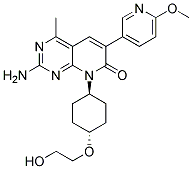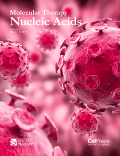All AbMole products are for research use only, cannot be used for human consumption.

PF-04691502 is an ATP-competitive PI3K/mTOR dual inhibitor, which potently inhibited recombinant class I PI3K and mTOR in biochemical assays and suppressed transformation of avian fibroblasts mediated by wild-type PI3K γ, δ, or mutant PI3Kα. PF-04691502 inhibited mTORC1 activity in cells as measured by PI3K-independent nutrient stimulated assay, with an IC(50) of 32 nmol/L and inhibited the activation of PI3K and mTOR downstream effectors including AKT, FKHRL1, PRAS40, p70S6K, 4EBP1, and S6RP. PF-04691502 reduced phosphorylation of AKT T308 and AKT S473 (IC(50) of 7.5-47 nmol/L and 3.8-20 nmol/L, respectively) and inhibited cell proliferation (IC(50) of 179-313 nmol/L) in PIK3CA-mutant and PTEN-deleted cancer cell lines. PF-04691502 induced cell cycle G(1) arrest, concomitant with upregulation of p27 Kip1 and reduction of Rb. PF-04691502 has entered phase II clinical trials.

Mol Ther Nucleic Acids. 2016 Nov 15;5(11):e384.
Enhanced Anticancer Activity of PF-04691502, a Dual PI3K/mTOR Inhibitor, in Combination With VEGF siRNA Against Non–small-cell Lung Cancer
PF-04691502 purchased from AbMole
| Cell Experiment | |
|---|---|
| Cell lines | BT20, U87MG, and SKOV3 cells |
| Preparation method | Cell proliferation assays. BT20, U87MG, and SKOV3 cells were plated at 3,000 cell/well in 96-well culture plates in growth medium with 10% FBS. Cells were incubated overnight and treated with DMSO (0.1% final) or serial diluted compound for 3 days. Resazurin was added to 0.1 mg/mL. Plates were incubated at 37°C in 5% CO2 for 3 hours. Fluorescence signals were read as emission at 590 nm after excitation at 530 nm. IC50 values were calculated by plotting fluorescence intensity to drug concentration in nonlinear curves. |
| Concentrations | 0~1000 nM |
| Incubation time | 3 days |
| Animal Experiment | |
|---|---|
| Animal models | SKOV3, U87MG, or NSCLC cells tumour xenograft models in Female nu/nu mice (6–8 weeks old) |
| Formulation | 0.5% methylcellulose in water suspension |
| Dosages | 0.5, 1, 5, and 10 mg/kg once daily |
| Administration | orally |
| Molecular Weight | 425.48 |
| Formula | C22H27N5O4 |
| CAS Number | 1013101-36-4 |
| Solubility (25°C) | DMSO 13 mg/mL |
| Storage |
Powder -20°C 3 years ; 4°C 2 years In solvent -80°C 6 months ; -20°C 1 month |
| Related PI3K Products |
|---|
| T-00127-HEV1
T-00127-HEV1 is a phosphatidylinositol 4-kinase III beta (PI4KB) inhibitor with an IC50 of 60 nM. |
| PI3Kγ inhibitor AZ2
PI3Kγ inhibitor AZ2 is a highly selective PI3Kγ inhibitor (The pIC50 value for PI3Kγ is 9.3). |
| NIBR-17
NIBR-17 is a pan-class I PI3K inhibitor with suitable pharmacokinetic properties and inhibits tumor growth. |
| RV-1729
RV-1729 is an inhibitor of the phosphatidylinositol 3-kinase-δ (PI3Kδ). |
| Vulolisib
Vulolisib is a potent and orally active phosphatidylinositol 3-kinase (PI3K) inhibitor, with IC50 values of 0.2 nM, 168 nM, 90 nM and 49 nM for PI3Kα, PI3Kβ, PI3Kγ and PI3Kδ, respectively. |
All AbMole products are for research use only, cannot be used for human consumption or veterinary use. We do not provide products or services to individuals. Please comply with the intended use and do not use AbMole products for any other purpose.


Products are for research use only. Not for human use. We do not sell to patients.
© Copyright 2010-2024 AbMole BioScience. All Rights Reserved.
